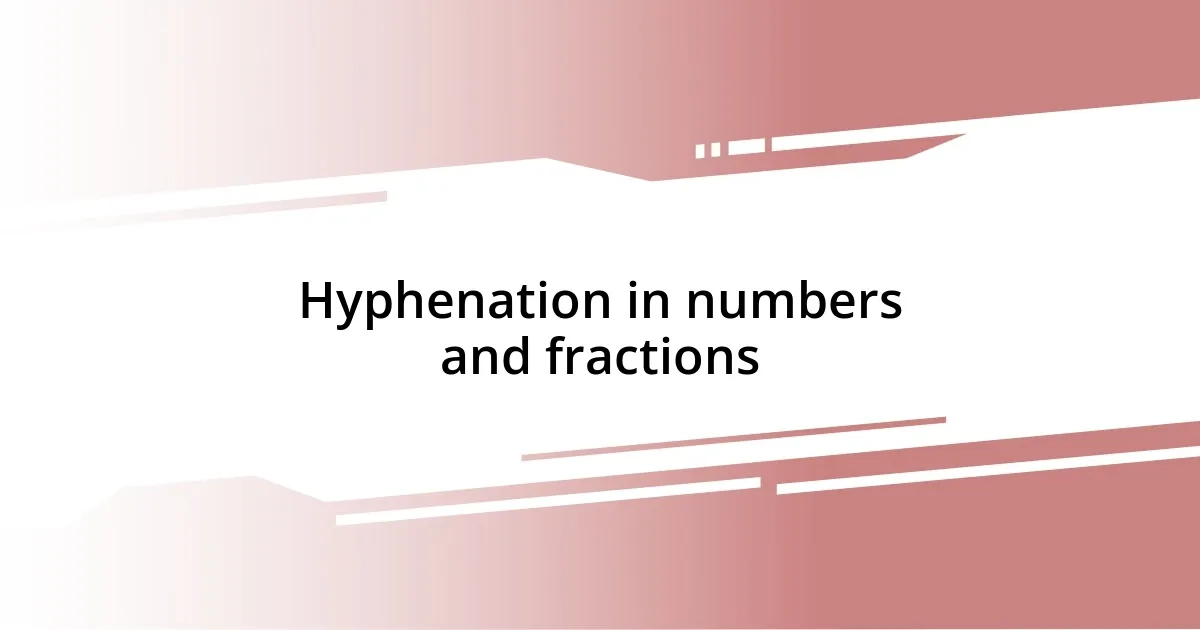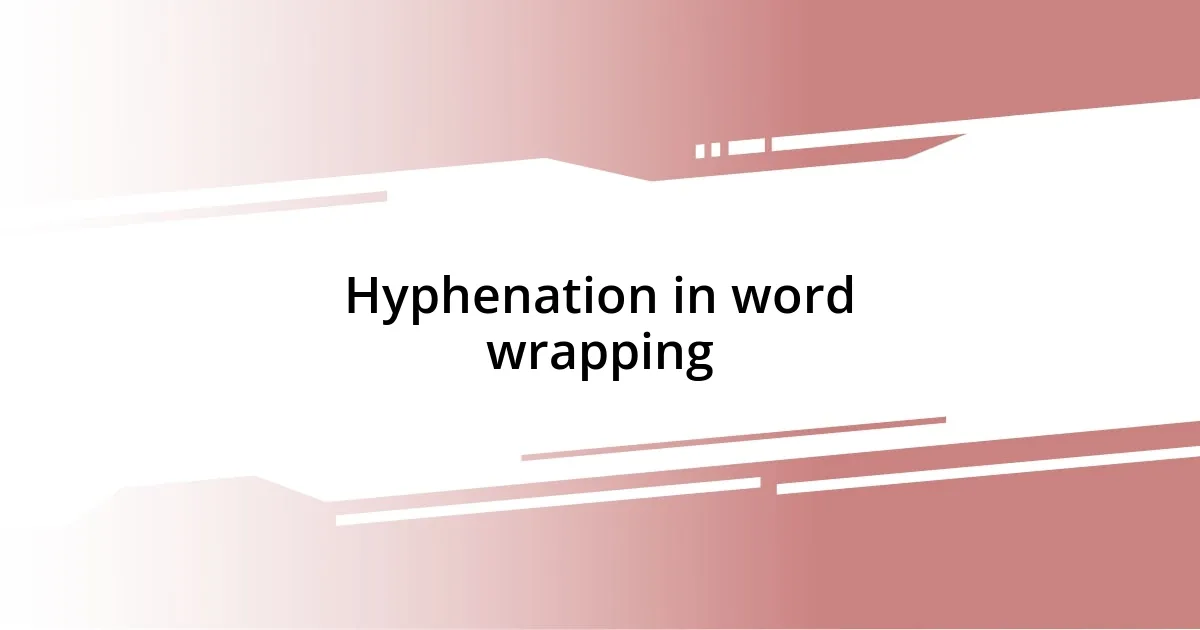Key takeaways:
- Compound adjectives require hyphenation when placed before a noun to ensure clarity (e.g., “high-quality product”).
- Hyphens are crucial in numbers and fractions for precise understanding (e.g., “two-thirds majority”).
- Proper hyphenation enhances professionalism and readability, impacting how writing is perceived by others.
- Resources like online grammar guides and writing groups can significantly improve hyphenation skills.

Understanding hyphenation rules
Hyphenation can feel a bit tricky at first, but once you grasp the rules, it opens a world of clarity and precision in writing. I remember my early days as a writer, when I felt uncertain about whether to hyphenate terms like “well known” or “high-quality.” After a bit of research, I learned that compound adjectives are hyphenated when they appear before a noun, which helped me eliminate guesswork and strengthen my writing.
One rule that stands out is the use of hyphens in compound numbers, like twenty-four or seventy-eight. These numbers can be surprisingly easy to overlook. At one point, I found myself double-checking each instance, feeling a mix of frustration and determination. I realized that understanding when to use hyphens not only makes my writing more accurate but also improves readability for my audience.
You might wonder, why does it even matter? Well, I’ve seen how a misplaced hyphen can alter the meaning of a phrase entirely. For example, “man-eating shark” versus “man eating shark” conveys two vastly different images! It’s these nuances that reinforce the importance of mastering hyphenation rules, turning writing from good to great.

Common mistakes in hyphenation
Common mistakes in hyphenation often stem from confusion about when to use them. I vividly recall a time when I mixed up terms like “long-term” and “long term.” It felt embarrassing to realize later that I had used them incorrectly in a report, which led to misunderstandings among my colleagues. Such slip-ups can easily distort the intended message.
Here’s a quick rundown of some common hyphenation errors to watch out for:
- Forgetting to hyphenate compound adjectives before nouns (e.g., “high-quality product” not “high quality product”)
- Hyphenating adverbs ending in -ly with adjectives (e.g., “beautifully crafted chair” not “beautifully-crafted chair”)
- Misplacing hyphens in compound numbers or fractions (e.g., “two-thirds” not “two thirds”)
Keeping these in mind can help solidify your writing clarity and accuracy.

Benefits of proper hyphenation
Proper hyphenation brings clarity and precision to your writing, which is something I’ve come to appreciate over the years. There was a time when I submitted a piece filled with ambiguous phrases that left my readers puzzled. After understanding the benefits of hyphenation, I noticed how it transformed my work by removing any potential confusion. It’s such a relief to know that a simple hyphen can guide readers to the intended meaning, enhancing both comprehension and engagement.
Another significant benefit of proper hyphenation is its impact on professional perception. When I first started freelancing, I received feedback about my writing style. At the time, I underestimated how minor grammatical issues could shape a client’s view of my abilities. I learned that polished writing, complete with correct hyphenation, not only elevates the content but also builds credibility. Clients want to see attention to detail, and proper hyphenation speaks volumes about the care you put into your work.
Moreover, understanding and applying proper hyphenation can lead to a more enjoyable writing experience. I remember feeling frustrated when reading through my drafts—so many sentences felt awkward! Once I incorporated the rules of hyphenation, I found it easier to express my thoughts clearly. It was as if a weight lifted off my shoulders, allowing my creativity to flow more freely. This clarity not only benefits me as a writer but also provides a better experience for my readers.
| Benefit | Description |
|---|---|
| Clarity | Hyphenation helps eliminate confusion in writing, ensuring that readers grasp the intended meaning without ambiguity. |
| Professionalism | Proper hyphenation enhances the overall quality of writing, contributing to a positive impression on clients and peers. |
| Enjoyment | Correct usage of hyphenation can make the writing process smoother and more enjoyable, allowing for clearer expression of ideas. |

Hyphenation in compound adjectives
Hyphenation in compound adjectives is one of those nuanced areas of grammar that can significantly alter the meaning of a sentence. I remember a project where I described a “high-quality image.” Admittedly, I mishandled that phrase initially and wrote “high quality image,” which inadvertently could suggest “image of high quality” rather than “high-quality image.” It actually made me pause and reflect on how one little hyphen can provide clarity and precision in writing.
One common scenario that I’ve encountered involves adjectives paired with proper nouns, like “New York-based consultant.” At first glance, it might seem optional to hyphenate, but it truly affects understanding. In my experience, skipping that hyphen could lead to misunderstandings. The phrase without the hyphen almost makes it sound like I’m describing a consultant who is somehow “based” in New York, which muddles the meaning. I’ve learned firsthand that properly hyphenating compound adjectives can keep the message on track.
Considering adverbs can also complicate matters. I recall a time when I excitedly wrote “widely respected author,” thinking the absence of a hyphen wouldn’t matter. To my surprise, some readers misinterpreted it as if I meant the author was merely “widely respected” instead of focusing on the two words together. When I dove deeper into the rules, the “light bulb” moment struck—hyphenation helps bind those adjectives together and creates a more cohesive description. I can’t stress enough how much clarity in writing helps prevent miscommunication, making it essential for effective storytelling.

Hyphenation in numbers and fractions
Hyphenation plays a crucial role when numbers and fractions come into play. I remember drafting a report where I wrote “a two third majority,” thinking that leaving it unhyphenated would be fine. It wasn’t until a colleague pointed it out that I realized how “two-thirds majority” clarifies that I’m indeed referring to a majority made up of two-thirds. It’s fascinating how adding that little dash shifts the meaning entirely, making me more vigilant about hyphenating numbers and fractions in my writing.
Using hyphens with numbers also applies to age. For instance, when I described a “five-year-old child,” I initially omitted the hyphen. It changed the entire context of my sentence. I could have misled readers into thinking I was discussing a child producing five years of age instead of referring to their age as a concise phrase. Trust me, getting the hyphen right has taught me to take that extra moment to ensure I convey my thoughts correctly.
When it comes to fractions, I’ve learned that the common hyphenation practice can help clarify meaning, especially in statistical writing. I recall a time I mentioned “three-fifths of the population” without a hyphen. The feedback I received helped me realize that “three-fifths” should be hyphenated to emphasize the fraction as one cohesive unit rather than two separate numbers. It reinforced my belief that proper hyphenation makes numerals feel more integrated and intentional. Isn’t it intriguing how these minute details can significantly elevate the precision of what we write?

Hyphenation in word wrapping
Hyphenation is especially vital when considering word wrapping, which is often overlooked in daily writing. I remember a time while working on a presentation where a long, unhyphenated phrase awkwardly wrapped to the next line, leading to confusion about its meaning. I realized that adding a hyphen could help ensure the phrase remained intact, like “first-rate service” rather than breaking it into “first-” on one line and “rate service” on the next. This clarity becomes more critical in digital formats, where word wrapping can alter how sentences are interpreted.
Sometimes, I get lost in the flow of words and forget how word wrapping affects readability. One particular instance that stands out involved a blog post I wrote about customer engagement strategies. A comment from a reader pointed out how my phrases with compound modifiers were split across lines, making them difficult to read. I felt a little embarrassed but thankful for the awareness it brought. It reinforced a lesson I had learned about hyphenation not just being grammar-related but also crucial for reader comprehension.
In my endeavors, I’ve come to believe that effective hyphenation in word wrapping can truly enhance the reader’s experience. When I distribute my content across digital platforms, I pay special attention to how phrases might wrap during layout changes. Have you ever read something and had to reread it due to split phrases? I know I have, and it can be frustrating! So now, I make it a point to hyphenate when necessary. It’s about creating a seamless flow that respects the reader’s time and attention. The little dash really does make a big difference!

Resources for mastering hyphenation
When it comes to refining my understanding of hyphenation, I’ve found that online grammar guides and resources are invaluable. One website I keep returning to is the Purdue Online Writing Lab (OWL). It offers clear explanations and examples that have helped me grasp the intricacies of hyphen usage, especially in complex sentences. After reading a detailed entry about compound adjectives, I finally learned how a well-placed hyphen can change a whole sentence’s meaning. Have you ever felt relief when finally cracking a grammar puzzle? That’s exactly how I felt!
I also discovered that investing time in grammar-check tools can take my writing to the next level. Initially, I wasn’t convinced they’d make a difference, but after using a tool like Grammarly, I found it flagged hyphenation errors I would have missed. One time, while drafting a business email, it pointed out that I had mistakenly written “high school student” as “highschool student.” It was a small oversight that could’ve detracted from my professionalism. Isn’t it amazing how technology can actually serve to enhance our writing practices?
Additionally, I highly recommend joining writing groups or forums where members exchange critiques and insights. A member once shared their experience with hyphenation that opened my eyes to the subtlety of language. They talked about how writing “twenty-five” instead of “twenty five” not only carried grammatical weight but also added a touch of professionalism. I started to see how networking with fellow writers can keep our knowledge fresh and adaptable. What resources have you turned to for mastering tricky writing conventions? I’m always on the lookout for insightful recommendations!













